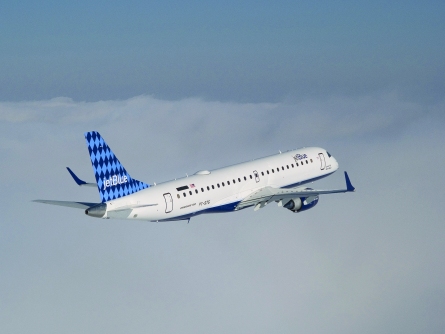The sudden popularity of the E-Jet concept has brought corporate pleasure and growing pains to Brazilian airframer Embraer. Pleasure because sales of the E-170/175/190/195 have exceeded 600 units pain because the popularity exceeded Embraer's expectations and planning.
"Success brings a lot of challenges," says Mauro Kern, Embraer executive vice-president, airline market. Those challenges include boosting monthly production from 10-11 aircraft to 14 by year-end, deploying more money and resources into customer support to handle "the very broad acceptance of the product at such a high pace", and rapidly increasing dispatch reliability in the midst of "so many new customers and new airlines starting operations at the same time", he says.
The diversity in the customer base has been an ongoing challenge for Embraer despite its efforts to anticipate problems during the design and development of the aircraft family. Potential issues were captured early on in a "maturity plan", a list of pitfalls gathered from lessons learned from previous programmes and general industry experience. The plan was an integral part of design reviews in the development phase and later in flight testing, says Kern. In addition, Kern says Embraer had its business partners and suppliers "carry out a lot more testing than would be required for certification", including endurance testing and "extreme" environmental testing to stress the components "far beyond" certification limits.
Although comprehensive, the plan was not foolproof. "We could not capture the high number of different operational scenarios with the maturity programme," says Kern. "Many issues have been prevented by this, but unfortunately, a few of them escaped. Very fortunately, we don't see any safety issues coming out."
Rather, Kern sees the handful of post-delivery mechanical and software issues that have surfaced as annoyances to operators. Chief among the mechanical headaches that airlines have experienced are cargo doors that jam during cold weather operations and others that may not be fully closed on take-off, issues experienced to some extent by Finnair, JetBlue and LOT.
"We acknowledge there are issues in severe winter weather," says Kern. He blames dimensional tolerances in the opening mechanisms and says "some improvements" have already been made in terms of maintenance servicing and ways to prevent water from accumulating in the area, exacerbating the problem. A permanent fix - redesigned opening and locking mechanism parts that do not experience differential contraction at extremely low temperatures - will be available to airlines in the form of a service bulletin this month, he says. That will give affected operators time to install the fix, covered under warranty, before the next cold season, he says.
Other cargo door problems were more urgent, and the subject of a US Federal Aviation Administration emergency airworthiness directive in March. The action came after a JetBlue E-190 rear cargo door opened just after take-off and an Air Canada E-170 front cargo door was discovered to be open on the ground. The AD required immediate inspections for interference between the lock handle and the aft edge liner assemblies, as well as replacement of the assemblies within 150 flight cycles. In addition, pilots or mechanics were (and still are) required to verify that the door is closed - flush with the fuselage skin - and that all four "latched and locked" indicators at the bottom of the doors are green before take-off.
Kern says a service bulletin addressing the root cause of the problem - the location and design of small steel plates that could prevent the door from locking - will be available in June, again covered under warranty. Once installed, the new equipment will negate the need for the AD's extra inspections and pre-flight checks. Kern says Embraer plans to have the new parts installed on the entire fleet by year's end.
|
|---|
The in-flight opening of a cargo door on a JetBlue E-190 resulted in an FAA airworthiness directive |
Problems with escape slides on LOT's older E-170s, according to Embraer, were linked to the slide-packing interval, a task usually performed every three years. An interim fix will require repacking the slides every 30 months instead, says Kern. A final improvement, now in design at Embraer, will return the slides to the standard repacking interval.
Leaking shock absorber seals, a problem reported by Paramount Airways for its E-170s and E-175s, have been fixed through a service bulletin, and no further reports of problems have come in since February, says Kern.
Regarding the widely reported software issues, Kern says "nuisance" messages that many operators experienced early on with the aircraft's highly integrated Honeywell-built Primus Epic avionics suite have been solved. "Through subsequent software versions, we very rapidly were able to address and correct the software so that the number of software problems today is very, very small," he says.
The Primus Epic handles the digital avionics, integrated utilities and fly-by-wire flight controls on all E-Jets, a level sophistication that is only surpassed by the Airbus A380 and future aircraft like the Boeing 787 in the transport sector, says the company.
E-Jet fleet technical dispatch reliability (TDR) is increasing as problem areas are addressed, says Embraer. For the 230 aircraft in service, TDR was 98.7% and trip completion rate 99.8%, according to Kern. He says the TDR is approaching Embraer's internal goal of 99.3%, a number that is on par with what Airbus and Boeing achieve with their narrowbody families. For the most mature aircraft in the fleet, the E-170, Kern says schedule interruptions are down 30-40% compared with service entry.
As of the end of April, the fleet had accumulated 718,000h and 419,000 cycles, with average flight durations for the E-170/175 at 1.4h per leg and average durations for the E-190/195 of 1.6h.
Kern says some aircraft fly legs shorter than 1h, others fly routes as long as 4.5h. Daily utilisation for the E-170/175 is roughly 7h compared with 8h for theE-190/195. "The trend is increasing," he adds.
For more Airbus A380 related news, please visit our A380 page
Source: Flight International









































